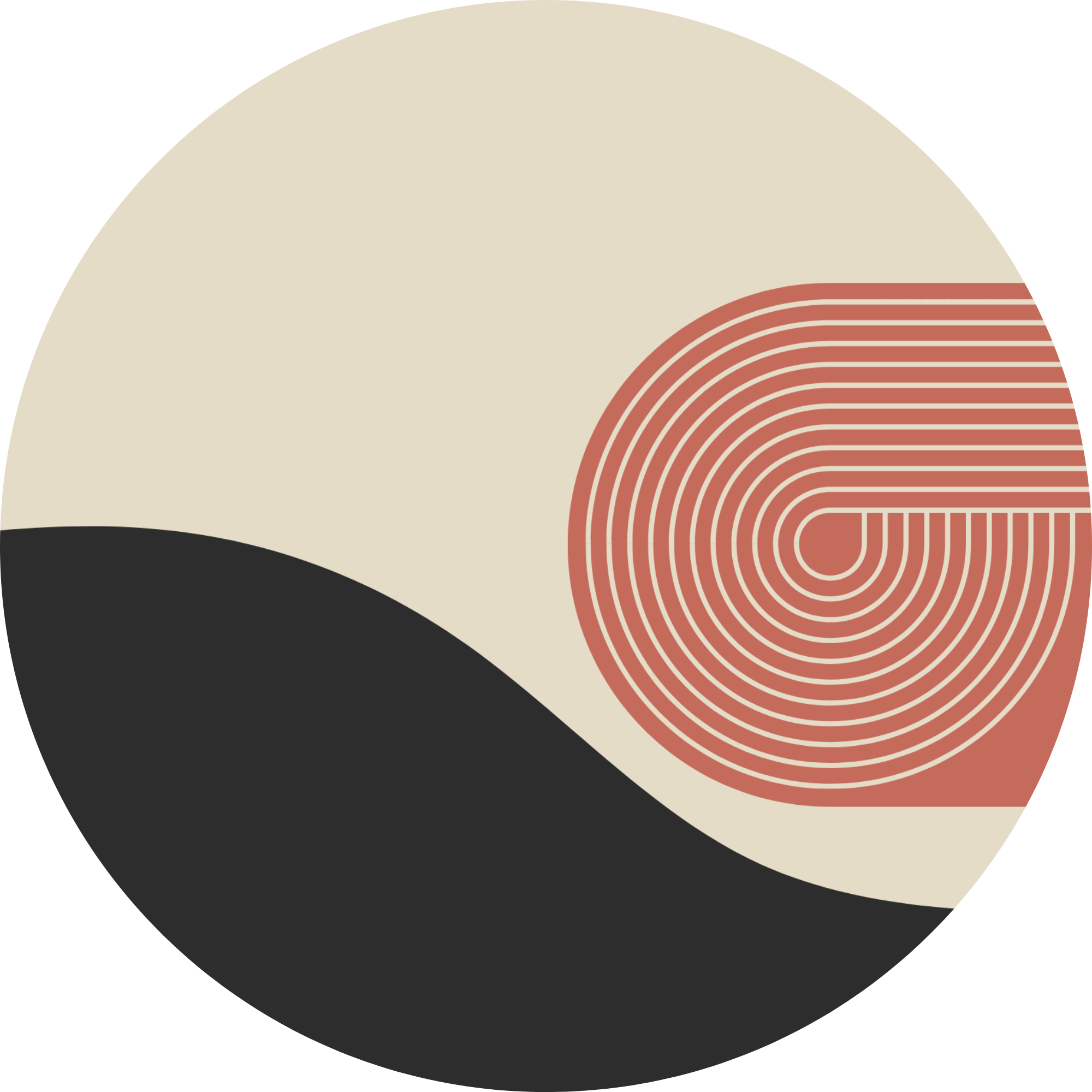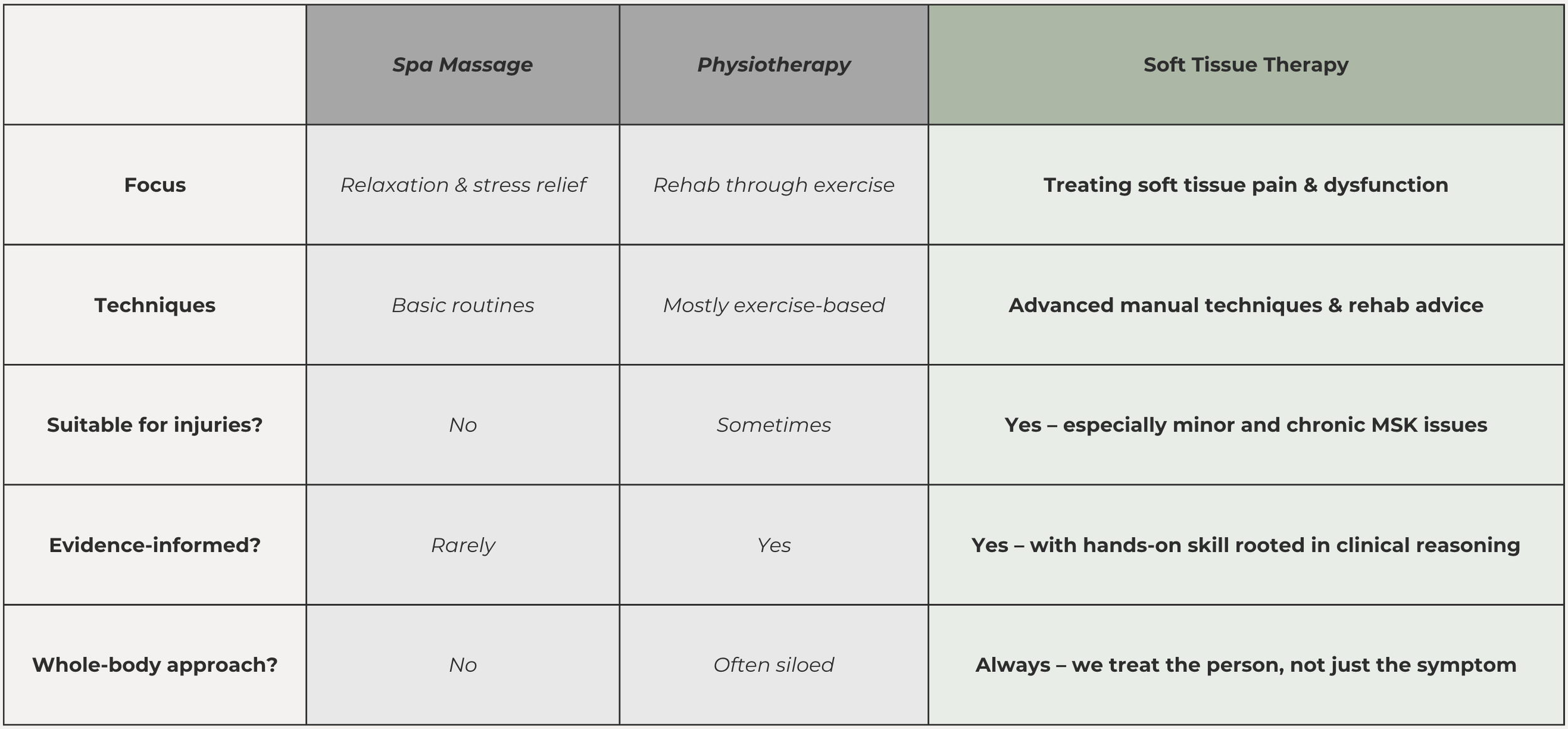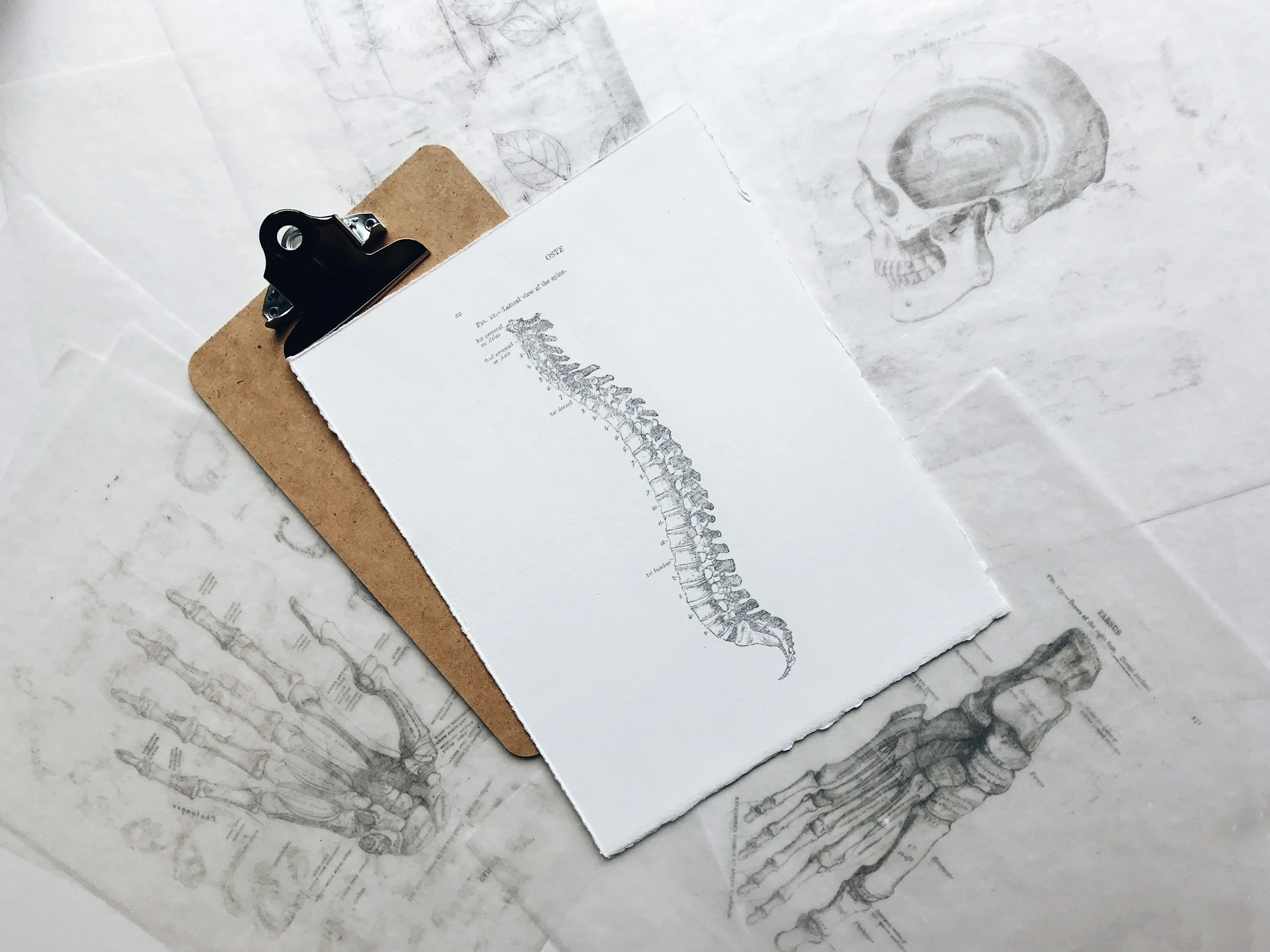What is Soft-Tissue Therapy?
Soft-Tissue Therapy goes beyond traditional sports therapies and massage. It’s a clinical approach to treating pain, injury and dysfunction in the body - whether from sport, work, lifestyle or age - using advanced, evidence-informed, hands-on techniques.
It combines deep knowledge of anatomy and movement with practical, tactile skill to support people in pain. From the moment you walk in, you’re not just a body part; you’re a whole person, and your treatment reflects that.
What’s involved?
Soft-Tissue Therapy draws on a broad toolbox of techniques, including:
-
Myofascial release works with the connective tissue system that surrounds and links muscles, joints, and organs. Restrictions within fascia can alter movement, load distribution, and pain patterns across the body.
MFR involves sustained, controlled pressure to restore glide and elasticity within the tissue. This can feel intense at times, particularly in areas of long-standing restriction, but it is applied purposefully and with clinical intent rather than force.
-
STR combines precise manual pressure with active or assisted movement. As the tissue is placed under tension, specific restrictions are addressed while the muscle is lengthening.
This approach is particularly effective for improving range of motion, reducing protective guarding, and restoring more efficient movement patterns.
-
NMT focuses on areas of altered muscle tone and trigger points that may be contributing to pain, dysfunction, or referred symptoms.
The aim is to normalise communication between the nervous system and the muscle tissue, reducing inappropriate tension and improving coordination and load tolerance.
-
METs use gentle, controlled muscle contractions performed by the client against resistance.
These include:
Post-Isometric Relaxation (PIR), used to reduce excessive muscle tone and improve length
Reciprocal Inhibition (RI), used to facilitate relaxation through opposing muscle groups
METs are highly specific and allow precise changes in joint position, muscle tone, and range without aggressive force.
-
These techniques involve placing the body or a specific tissue into a position of comfort to reduce protective reflex activity within the nervous system.
They are particularly useful for highly sensitive or reactive tissues, acute pain presentations, or when deeper techniques are not clinically appropriate.
-
“Deep tissue” massage is one technique, not a treatment approach.
When clinically indicated, deeper pressure can be extremely effective. However, applying deep pressure indiscriminately can aggravate tissues, increase guarding, or slow recovery.
Soft Tissue Therapists are trained to assess when deeper techniques are appropriate and when alternative methods will achieve better results with less strain on the body.
It’s not about doing a routine or following a script, it’s about assessing what your body needs on the day, and applying the right blend of techniques to create meaningful change.
find out what to expect from Clinical Soft Tissue Therapy treatment here
Soft-Tissue Therapy is for anyone experiencing pain, tension, or dysfunction in their body, regardless of age, fitness level, or lifestyle.
I work with:
People with desk-based jobs dealing with neck, shoulder or back pain
Parents or carers with chronic tension or repetitive strain
Older adults looking to improve mobility, manage chronic aches or prevent decline
People recovering from injury, surgery or long-standing pain
Those with stress-related physical symptoms like jaw tension or upper back pain
Recreational or professional athletes wanting to prevent injury and recover more effectively
People with fibromyalgia and CNS conditions
Anyone who has been told to “just live with it” and is ready to try something that looks at the bigger picture
If you have a body, and it’s not moving or feeling quite right, this therapy is likely to help.
Who is it for?
Medical conditions
If you have a medical condition and would like to discuss whether Soft Tissue Therapy is appropriate for you, please don’t hesitate to get in touch.
As a general guide, I am qualified and fully insured to work with clients who have the following conditions, subject to individual assessment:
-
These are very safe and expected:
Chronic pain conditions
Fibromyalgia
Non-specific low back pain
Neck and shoulder pain
Tension-type headaches
Temporomandibular joint (TMJ) dysfunction
Repetitive strain injuries (RSI)
Postural-related pain and dysfunction
-
Neurological conditions affecting the central nervous system (CNS)
Persistent pain with nervous system sensitisation (such as Fibromyalgia)
Stress-related muscle tension and autonomic overload
-
Hypermobility spectrum conditions
Joint instability–related muscle pain
-
Pregnancy (with appropriate adaptations)
Postnatal recovery
Fertility-related considerations
Endometriosis & PCOS
-
Post-injury rehabilitation (acute or chronic)
Post-surgical recovery (once medically cleared)
Scar tissue and post-operative soft tissue restriction
-
Desk-based and sedentary work-related pain
Manual work and occupational load-related pain
Sport, and training-related muscle and soft tissue issues
How is this different from massage or physiotherapy?
What conditions can STT help with?
Soft Tissue Therapists are trained to assess clients at a clinical level. This means we are qualified to treat patients with complex medical conditions. Soft Tissue Therapy techniques are inherently safe and can be used to treat and support recovery from:
Chronic muscular pain
Neck, shoulder and lower back pain
Postural dysfunction
Repetitive strain injuries
Headaches and jaw tension
Tendon issues (e.g. tennis elbow, Achilles tendinopathy)
Sports or activity-related injuries
Pre- and post-operative recovery
Stress-related physical tension
Soft-Tissue Therapy sees the whole picture
What makes Soft Tissue Therapy so powerful is its ability to connect the dots. It’s not about chasing symptoms or ticking boxes. It’s about understanding how the body really works, and how your pain might be influenced by posture, stress, old injuries, sleep, your daily habits: the whole picture.
I don’t treat injuries.
I treat people with injuries.
FAQs
-
Soft-Tissue Therapy goes far beyond what most people think of as massage. It uses advanced clinical techniques to assess and treat soft tissue injuries and dysfunction. While hands-on work is still part of what I do, it’s applied with purpose — not just for relaxation, but to improve function, reduce pain, and support recovery.
-
No — ‘Soft-Tissue’ refers to what I treat, not how I treat it.
The term “soft tissue” describes muscles, fascia, tendons and ligaments — the structures that support and move the body. So Soft-Tissue Therapy means I work with those tissues — not that I use a soft or gentle pressure. In fact, treatments can range from very light to very deep, depending on what your body needs. This is clinical work, not spa massage — and while I always work within your comfort, I’m often working deep into dysfunctional tissue to help restore movement and reduce pain. -
Not at all. Many people I work with aren’t dealing with a specific injury — they might have ongoing back or neck pain from sitting all day, tension they can’t seem to shift, or just feel that something isn’t moving quite right. Whether it’s pain, stiffness, or general discomfort, Soft-Tissue Therapy can help.
-
Yes — in fact, Soft-Tissue Therapy is particularly well suited to chronic issues that haven’t responded to other types of treatment. We don’t just treat the symptoms — we look at the bigger picture, identify contributing factors, and work together to find sustainable solutions.
-
Please wear comfortable clothing that allows easy access to the area being treated. Depending on the treatment, you may be asked to remove some clothing — but you’ll always be draped appropriately and your comfort will be prioritised. If you prefer, many techniques can be performed through light clothing.
-
A standard session is typically 45 - 60 minutes, which includes a short consultation, assessment, hands-on treatment, and any aftercare advice. First appointments may take a little longer to allow time for a more in-depth discussion and assessment.
-
It really depends on the issue. Some people feel a big difference after just one or two sessions, while others benefit from a short course of treatments — especially for long-standing or complex problems. We’ll discuss your goals at your first appointment and create a plan that works for you. Ongoing maintenance packages at reduced rates are available.
-
No — Soft-Tissue Therapy shouldn’t hurt. There's a common misconception, often reinforced by poorly trained “sports massage” therapists, that pain equals progress. That’s simply not true.
Some techniques might feel tender, especially if we're working on tight or sensitive areas, but pain isn't the goal — and it’s never necessary for a treatment to be effective. In fact, overly aggressive techniques can cause unnecessary trauma to the tissues, increase inflammation, and slow down your recovery.
Most of the time, we're asking your tissues to relax. I don’t know about you, but if someone was digging their elbow into my glutes while telling me to relax, I’d probably do the opposite. That’s why I always work with your body, not against it — adjusting pressure and technique based on your response and what we’re trying to achieve. You’ll always be in control, and I’ll always check in with you during treatment.
-
Yes. Soft-Tissue Therapy is for everyone — including older adults, people recovering from surgery, or those managing chronic conditions. Techniques can be adapted for comfort and mobility, and many of them are gentle but highly effective.
I can come to you, which means you don’t need to worry about travel. -
If you’re pregnant and experiencing musculoskeletal pain, please get in touch. I may be able to help, depending on your stage of pregnancy and the nature of the issue — and if not, I’ll happily refer you to a therapist who specialises in this area.
-
No — formal diagnosis is outside the scope of Soft-Tissue Therapy. However, I can assess your movement and soft-tissues, and work with you to understand what might be contributing to your symptoms. If I ever feel your case needs onward referral (to a GP, physio or consultant), I’ll always tell you.
-
That’s exactly why many people end up here. Soft-Tissue Therapy fills a gap between passive relaxation massage and exercise-based physiotherapy. If you feel like you’ve slipped through the cracks in the system, you’re not alone — and you may find this approach is exactly what you’ve been looking for.
-
You’re not alone — lots of people are! (I’m ticklish too.)
I’ve developed a unique and very effective way of working with ticklish clients that allows us to get meaningful results without triggering that reflex. Most of the time, it’s completely manageable with the right technique, pressure and pace. You’ll never be pushed beyond your comfort zone, and I’ll always check in as we go.
If it’s something you’re worried about, just let me know — I’m used to adapting for all kinds of bodies and nervous systems.







